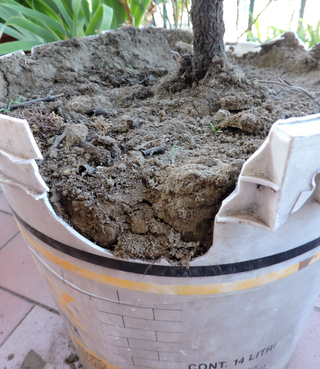Antioxidants
Antioxidants inhibit autoxidation that occurs when polymers reacts with atmospheric oxygen. [5] Aerobic degradation occurs gradually at room temperature, but almost all polymers are at risk of thermal-oxidation when they are processed at high temperatures. The molding or casting of plastics (e.g. injection molding) require them to be above their melting point or glass transition temperature (~200-300 °C). Under these conditions reactions with oxygen occur much more rapidly. Once initiated, autoxidation can be autocatalytic. [6] As such, even though efforts are usually made to reduce oxygen levels, total exclusion is often not achievable and even exceedingly low concentrations of oxygen can be sufficient to initiate degradation. Sensitivity to oxidation varies significantly depending on the polymer in question; without stabilizers polypropylene and unsaturated polymers such as rubber will slowly degrade at room temperature where as polystyrene can be stable even at high temperatures. [7] Antioxidants are of great importance during the process stage, with long-term stability at ambient temperature increasingly being supplied by hindered amine light stabilizers (HALs). Antioxidants are often referred to as being primary or secondary depending on their mechanism of action.
Primary antioxidants (radical scavengers)

Primary antioxidants (also known as chain-breaking antioxidants) act as radical scavengers and remove peroxy radicals (ROO•), as well as to a lesser extent alkoxy radicals (RO•), hydroxyl radicals (HO•) and alkyl radicals (R•). Oxidation begins with the formation of alkyl radicals, which are formed when the high temperatures and high shear stress experienced during processing snaps the polymer chains in a homolytic manner. These alkyl radicals react very rapidly with molecular oxygen (rate constants ≈ 107–109 mol–1 s–1) to give peroxy radicals, [8] which in turn abstract hydrogen from a fresh section of polymer in a chain propagation step to give new alkyl radicals. [9] [10] The overall process is exceedingly complex and will vary between polymers [11] but the first few steps are shown below in general:
- R-R → 2 R•
- R• + O2 → ROO•
- ROO• + RH → ROOH + R•
Due to its rapid reaction with oxygen the scavenging of the initial alkyl radical (R•) is difficult and can only be achieved using specialised antioxidants [12] the majority of primary antioxidants react instead with the longer lasting peroxy radicals (ROO•). Hydrogen abstraction is usually the rate determining step in the polymer degradation and the peroxy radicals can be scavenged by hydrogen donation from an alternative source, namely the primary antioxidant. This converts them into an organic hydroperoxide (ROOH). The most important commercial stabilizers for this are hindered phenols such as BHT or analogues thereof and secondary aromatic amines such as alkylated-diphenylamine. Amines are typically more effective, but cause pronounced discoloration, which is often undesirable (i.e., in food packaging, clothing). The overall reaction with phenols is shown below:
- ROO• + ArOH → ROOH + ArO•
- ArO• → nonradical products
The end products of these reactions are typically quinone methides, which may also impart unwanted colour. [13] Modern phenolic antioxidants have complex molecular structures, often including a propionate-group at the para position of the phenol (i.e. they are ortho-alkylated analogues of phloretic acid). [14] The quinone methides of these can rearrange once to give a hydroxycinnamate, regenerating the phenolic antioxidant group and allowing further radicals to be scavenged. [15] [16] Ultimately however, primary antioxidants are sacrificial and once they are fully consumed the polymer will begin to degrade.
Secondary antioxidants (hydroperoxides scavengers)

Secondary antioxidants act to remove organic hydroperoxides (ROOH) formed by the action of primary antioxidants. Hydroperoxides are less reactive than radical species but can initiate fresh radical reactions: [6]
- ROOH + RH → RO• + R• + H2O
As they are less chemically active they require a more reactive antioxidant. The most commonly employed class are phosphite esters, often of hindered phenols e.g. Tris(2,4-di-tert-butylphenyl)phosphite. [17] These will convert polymer hydroperoxides to alcohols, becoming oxidized to organophosphates in the process: [18] [19]
- ROOH + P(OR')3 → OP(OR')3 + ROH
Transesterification can then take place, in which the hydroxylated polymer is exchanged for a phenol: [20]
- ROH + OP(OR')3 → R'OH + OP(OR')2OR
This exchange further stabilizes the polymer by releasing a primary antioxidant, because of this phosphites are sometimes considered multi-functional antioxidants as they can combine both types of activity. Organosulfur compounds are also efficient hydroperoxide decomposers, with thioethers being particularly effective against long-term thermal aging, they are ultimately oxidise up to sulfoxides and sulfones. [21]
Antiozonant

Antiozonants prevent or slow down the degradation of material caused by ozone. This is naturally present in the air at very low concentrations but is exceedingly reactive, particularly towards unsaturated polymers such as rubber, where it causes ozone cracking. The mechanism of ozonolysis is different from other forms of oxidation and hence requires its own class of antioxidant stabilizers. These are primarily derivatives of p-phenylenediamine (PPD) and work by reacting with ozone faster than it can react with vulnerable functional groups in the polymer (typically alkene groups). They achieve this by having a low ionization energy which allows them to react with ozone via electron transfer, this converts them into radical cations that are stabilized by aromaticity. Such species remain reactive and will react further, giving products such as 1,4-benzoquinone, phenylenediamine-dimers and aminoxyl radicals. [22] [23] Some of these products can then be scavenged by antioxidants.















